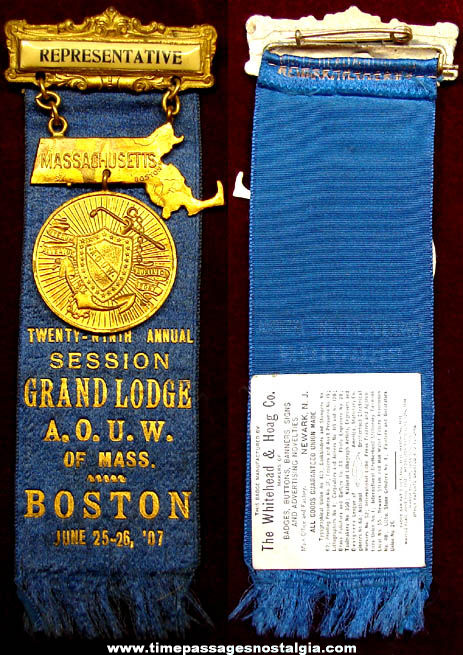
   | | Any group of items being offered as a lot must be sold as a lot. | | | Don't forget to
bookmark this site. | | Combined Shipping And Handling | | Quality Merchandise At Reasonable Prices | | We have an extensive inventory that is not yet on our web site. If there is something you are looking for and did not find, please send us your wish list. | | An Ever Changing Inventory | Great memories
make great gifts! | | Fast Dependable Service | It's never too late to
have a happy childhood! |
| | | | The picture shows a front and back view of this 1907 Ancient Order of United Workmen Representative Ribbon Badge. It has an imprinted celluloid pin back section at the top, a gold imprinted blue ribbon hanging from it, and two brass medals or charms hanging from chains. There is a paper label on the back of the ribbon. The first charm is in the shape of the State of Massachusetts woth Boston marked. The coin shaped medal or charm is blank on the back. The front has a ship anchor with an A.O.U.W. badge in front and rays behind. There is a long banner with print as well. The label on the back has a Union mark and it lists many different Unions. It is marked on the front and back as follows: REPRESENTATIVE
MASSACHUSETTS
A.O.U.W.
ALTERUM ALTERIUS AUXILIO EGET
TWENTY - NINTH ANNUAL SESSION
GRAND LODGE
A.O.U.W. OF MASS.
BOSTON
JUNE 25 - 26, '07 THIS BADGE MANUFACTURED BY
THE WHITEHEAD & HOAG; CO.
MAKERS OF
BADGES, BUTTONS, BANNERS, SIGNS, AND ADVERTISING NOVELTIES
MAIN OFFICE AND FACTORY NEWARK, N.J.
ALL GOOD GUARANTEED UNION MADE.
(long list of Unions)
BADGE BAR PAT'D OCT. 18, 1892, MARCH 7th, 1893.
WAVING FLAG, JUNE 14th, 1892, MEDALLION PAT'D JUNE 12th, 1894,
MARCH 5th, 1895, JUNE 12th, 1896.
OTHER PATENTS GRANTED ARE PENDING. The ribbon badge measures 5-1/2'' long. It appears to be in mint condition as pictured. Below here, for reference is some History and background information that was found about the A.O.U.W. from the Phoenixmasonry Masonic Museum: ANCIENT ORDER OF UNITED WORKMEN Fraternalism and Fraternal Benefits Societies are based on the simple premise that every person is his or her ''brothers keeper'', and therefore have a moral responsibility to each other. After the Civil War, the United States underwent a fundamental economic change, that also changed the ''fabric'' of society as well. As the railroads created the potential for national markets, factories built to satisfy those markets created opportunities that tempted many people to move away from the farms, villages, and hamlets to pursue their fortunes in the growing urban centers. But massive urbanization created a very real human need. Many found themselves lonely, alienated, and living on the financial brink. Most factory workers of the day worked long hours for meager wages, and had no form of insurance benefits to leave their dependents when they died. In the agrarian communities, the policies developed by the national governments to pay off the nations war debt were causing shortages in the supply of money and extremely high interest rates. As a result, farmers experiencing bad growing years were losing their farms in record numbers to satisfy their loans under the ''crop lien system.'' People moving west along the Oregon trail were faced with virtually the same problems faced by the European settlers 200 years before them. In response to these difficulties faced by million of Americans, Fraternal Benefit Societies, Mutual Benefit Associations, and Self Help Groups developed in the United States during this time to provide members with financial protection, a collective voice, and fraternal brotherhood. The American fraternal benefit network began with the organization the Ancient Order of United Workmen in Meadville, Pennsylvania on October 27, 1868. The AOUW was founded by John Jordan Upchurch, a Mason, with the aim of adjusting ''all differences which may arise between employers and employees, and to labor for the development of a plan of action that may be beneficial to both parties, based on the eternal truth that the interests of labor and capitol are equal and should receive equal protection.'' Each member paid $1 into the insurance fund to cover the sum of not less than $500 in benefits paid to a members dependents when he died. Each time a member died, $1 was due from the surviving members to reestablish the fund. Fraternal benefits societies soon became quite popular as a means of providing financial protection to working class people at an affordable rate. Additionally, Fraternal benefits societies typically maintained a lodge where members could meet together in a spirit of fraternalism and brotherhood. In at least one case - the Populist movement - the fraternity evolved into a powerful political organization providing a voice for their members. Although John Upchurch did not intentionally seek to establish a new system of insurance, the seed of his original idea was in fact planted. The crux of Upchurch's ideology was to ''bring together then conflicting social interests, capitol and labor, to provide a means of arbitration with which to settle difficulties that were constantly arising.'' However, that seed, once planted grew into the tree of mutual protection, ''under whose shelter millions today rest in security from want and dependence.'' The emblems and symbols used by the AOUW are steeped in Masonic attributes, featuring the All Seeing Eye, the Holy Bible, Anchor and Square and Compasses, over which the motto ''Charity, Hope and Protection'' are displayed. It even boasts of having three independent degrees as a rite of passage into the order. Its membership numbered in excess of 318,000 in 1895. Quoted from an excerpt of a lecture given by Upchurch defining the AOUW, the pervasiveness of the tenets of Masonry are easily recognized, when he said, ''Today we have members from the highest professions and the lowest grades of mechanical labor. We come into this organization on the same great level. It is not money, but it is purity of character and uprightness that brings us here, and we can take each brother by the hand as an equal. Brothers, in this organization we have done more to harmonize the human family, high and low, than all the other organizations that ever existed.'' |
|
Click on image to zoom.
 |